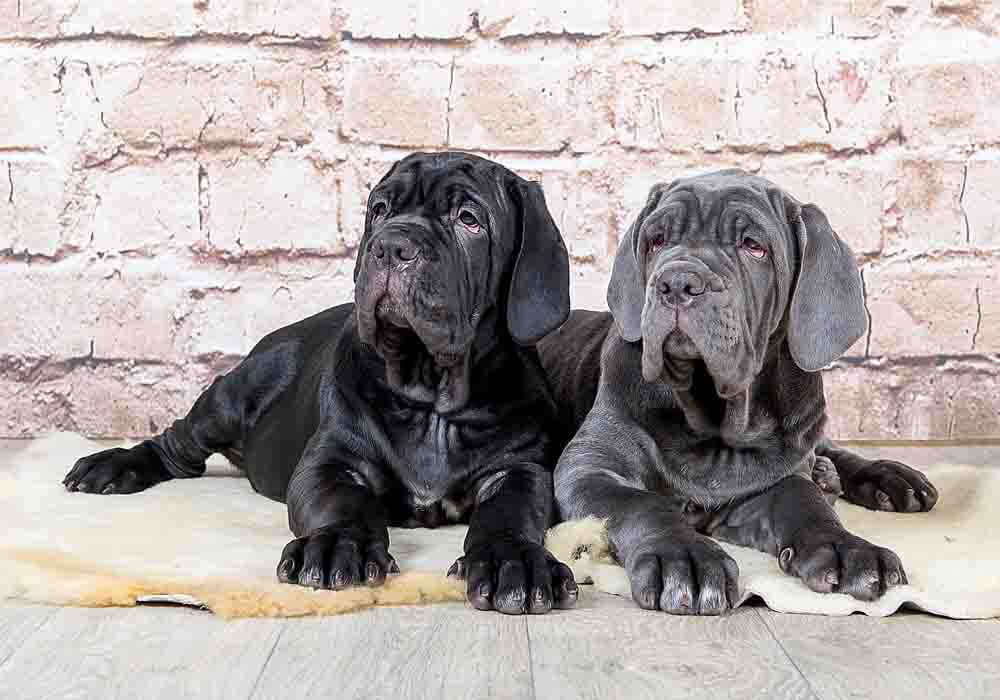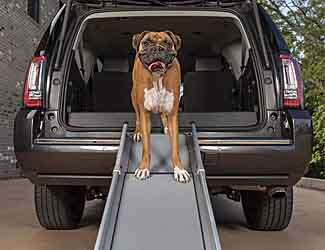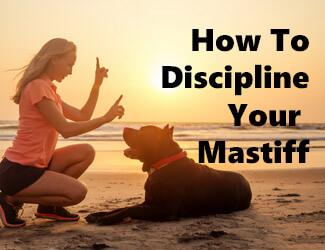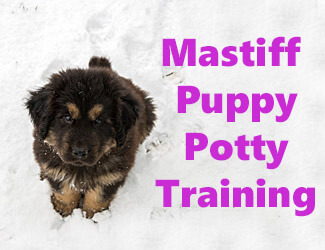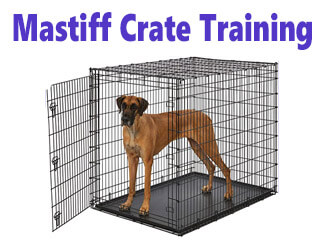How Do You Train
A Mastiff Puppy Not To Bite?
by Ken Alden
So how do you train a Mastiff puppy not to bite? If you already have or are looking to purchase a Mastiff puppy, you may be wondering the same thing. All puppies will bite because of their instincts, but it is important to train your Mastiff not to bite because, when fully grown, they are quite large, and their bites can cause injury.
How Do You Train A Mastiff Puppy Not To Bite?
Use training methods at home with toys and verbal commands and teach bite inhibition to prevent your Mastiff pup from biting. You can also send your puppy to a dog training school.
When training your puppy, remember that puppies are naturally social and curious creatures. However, Mastiff puppy teeth become a much bigger set of teeth with a large jaw as they get older, and biting becomes more dangerous rather than adorable. Read on below to find out how to teach your Mastiff puppy not to bite.
Pro-tip: Ever try lifting a Mastiff? Their weight can hurt not only your back but their joints when they hop down from cars, sofas or even your bed. To protect your back and theirs check out the best Mastiff ramps on Amazon.com now.
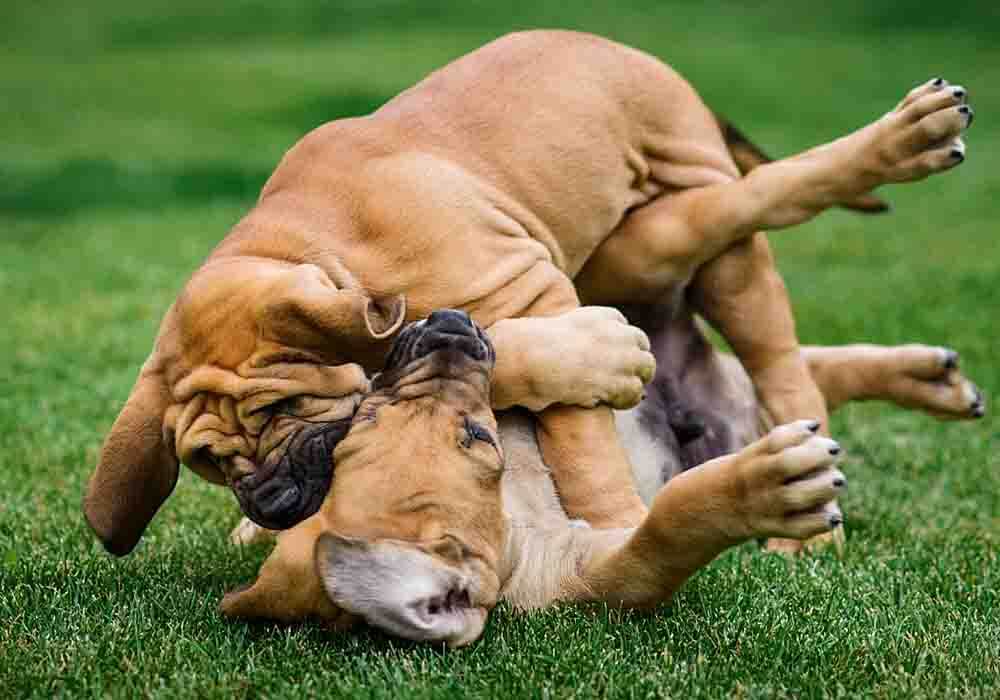
Methods For How To Stop A Mastiff Puppy From Biting Include...
- Play with your Mastiff pup regularly. This playtime will allow you time with your puppy to learn more about their behavior and to give you time to train them effectively and consistently.
- If your puppy begins to chew on something or bites you, tap them on the nose and say "no" in a clear and firm voice, being sure to get their attention. You don't want to hit your puppy or do them any harm.
- Giving your Mastiff plenty of chew toys early on helps with verbal corrections. Be sure the toys you purchase are appropriate for your puppy's age. It also helps to rotate through toys, so they don’t get bored with the toys too quickly. You may have to move a toy around in front of them and make some noise to get your puppy excited about it!
>> Here's our recommendations for great chew toys << - If your puppy finds something to chew on other than a chew toy, remove the item and replace it with a chew toy. Give your puppy praise for chewing on the appropriate toy. Be very persistent in doing this when you observe the biting behavior.
- Look into local puppy kindergarten or socialization classes. These can help your Mastiff learn from other dogs’ behaviors. If classes aren't offered in your area, or you don't want to fork out more money, try to find a way to introduce your dog to other dogs. Socialization is key to training them.
Don't be alarmed if these ideas take a few days or weeks to correct the
biting behavior. Puppies learn quickly, and once your puppy learns,
they will remember.
Pro-tip: Mastiff anxiety, aggression, destructive chewing, jumping up, fearfulness, and other behaviors can be controlled with the right training program.
Here’s a great course that
addresses these issues along with many other dog training basics: Check it out now!
So How Do You Train A Mastiff Puppy Not To Bite?
New dog owners may not be familiar with the term bite inhibition. Bite inhibition is a dog's ability to control the pressure of their mouth when biting to cause little or no damage to the subject of the bite. This behavior is common in carnivores.
When it comes to training a Mastiff puppy not to bite, an important part is teaching them bite inhibition. A puppy is like a baby and putting things in their mouths is how they explore the world around them. You don't want to take away this natural way of learning but rather help teach them to stop by learning the correct way.
Bite inhibition doesn't mean stopping the mouthing behavior altogether. That's too much to expect and would be equivalent to asking a human to tie their hands behind their back. Any dog may bite if provoked, but a dog with good bite inhibition that bites will cause no harm. It is a comfort zone that owners owe to themselves and their dogs.
How to Teach Bite Inhibition
To teach your puppy bite inhibition, you must establish effective and consistent communication with them. If your puppy bites you and your reaction is yelling, hitting, or screaming, they will think you are roughly playing back.
Additionally, you don't want to lash out and hurt your puppy. Doing so will only break the bond that you have built. Yelling can also be interpreted as "barking" back at them, which will make them think you are playing and get them more excited.
Normally, puppies learn bite inhibition by interacting with their mother and siblings. They play and bite each other, and when one bites too hard, they learn the natural consequences of playtime being brought to an abrupt stop.
One method of getting a Mastiff to stop biting is to ignore the dog immediately after biting. This action mimics what a puppy would naturally learn at a young age.
Pro-tip: Mastiff's (and their owners) love dog crates…and for good reasons. Crates keep dogs from mischief while you're away, are perfect for house training, for traveling by car, and provide the dog a place to de-stress. Check out the best Mastiff crates on Amazon.com now.
Tips and Tricks to Teach Bite Inhibition
If you decide to teach bite inhibition, you should be prepared to be diligent and calm with your Mastiff during the training.
- If your pup bites you and it is painful, tell your puppy that it hurts with as much sad emotion that you can manage. You can even whimper. You can also yelp as another puppy would.
- You don't want to pull away from your pup quickly because this often will encourage a game of "tug" that you will not win.
- Once your puppy gets the hang of it, you will want to continue practicing good bites by doing little drills with a reward afterward.
- Socialization with other dogs will naturally help with bite inhibition. Puppies are good peer learners. Try adding some time at a dog park as part of your training.
- Sometimes, your puppy will bite and latch on to what they are biting. If your puppy does not let go, try pushing into their mouth to prompt their gag reflexes, and they will then release. After you get your Mastiff to release, put him in puppy time-out for a short period.
About 30 to 60 seconds of time-out is enough. This process will need to be repeated every time they bite too hard. They will eventually learn that, by controlling their bites, they will be rewarded with more playtime and praise for good behavior.
Teaching Bite Inhibition with a Clicker
Some dog owners have found success with clicker training. It allows you to identify your puppy’s good behavior consistently. When your Mastiff pup makes a good decision, they will hear the clicker make a sound, which allows you to "applaud" them at the exact moment they make good choices.
Some tips for teaching bite inhibition with clicker training include:
- Put your hand in front of your puppy’s mouth. If they don’t bite, then you click and provide a treat along with plenty of praise.
- When they have conquered the first step, try waving your hand in front of their mouth, and if they don’t bite, do the same thing as above (click, treat, and praise).
- Remember that it will take time for them to build up their impulse control enough not to bite at anything that moves. Patience and time are crucial when training them to stop.
How Do You Train A Mastiff Puppy Not To Bite...Final Thoughts
All puppies will bite, but not all puppies will learn not to bite in the same way. Knowing the many different ways that you can use to train your Mastiff not to bite will make sure that you find a way that works for you and your pup.
Remember that patience is crucial to the success of this kind of training. Becoming upset or aggressive with your puppy will only hinder the training process.
Return to the top of this How Do You Train A Mastiff Puppy Not To Bite page

About the Author...
Ken Alden, a dedicated Mastiff owner for over eight years, is acclaimed for his expertise in care, grooming, and training. Read more About Me and my dog Shadow.
- Mastiff Guide Home ›
- Mastiff Training ›
- Train Mastiff Puppy Not To Bite


